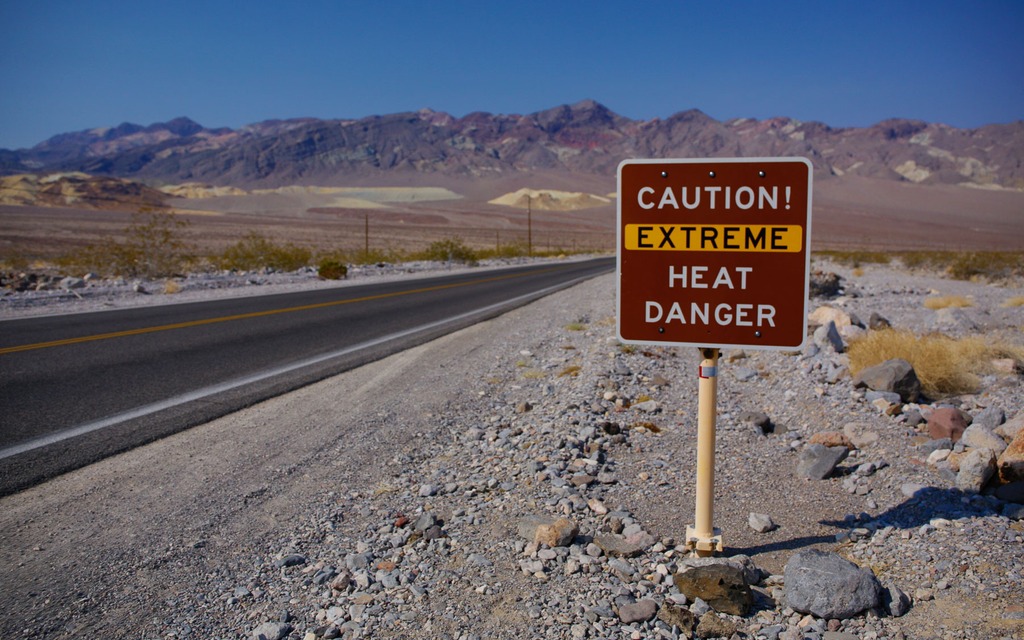Turning Up The Heat With Kia
DEATH VALLEY, California – When I was young, I loved checking out spy shots of camouflaged vehicles in car magazines. I’d admire the photographers who’d hide in the bushes with their enormous camera lenses, just waiting to snap a picture of a thinly – or painstakingly – disguised car as it was still in its development phase.
One of the best places to spot these test mules is in Death Valley, which is the hottest and driest area in North America. That’s where a great number of car manufacturers perform their hot-weather testing, including Kia, which invited us down to get an idea of how they fine-tune their vehicles before they reach dealerships. Namely, the redesigned 2017 Kia Sportage compact crossover, which we’ll be talking about in a couple of weeks.
We crossed paths with numerous camouflaged cars and trucks. Some were easy to guess, others were so heavily disguised we couldn’t even make out any stylistic cues that would reveal a particular make or model. Hyundai and Kia, General Motors, BMW and MINI, Mercedes-Benz and Toyota were all busy testing their new vehicles in Death Valley while we were there; we could get a clear picture of some, others were guarded by overzealous dudes who were constantly in our faces if we tried to get close for a snapshot.
What is hot-weather testing, exactly? In Kia’s case, it’s making sure a vehicle’s cooling and climate control systems function as they have been designed, both physically and logically. A lot of software programming is involved to ensure optimal temperatures in various driving situations as well as to keep the powertrain from overheating by reducing climate control performance.
Engineers will use a data collection system that’s mounted in the vehicles, connected to temperature sensors installed around the front and rear seats, the footwells and near the air vents of the dashboard. There’s also an outside temperature sensor mounted on the vehicle.
When one of Kia’s crews performs hot-weather testing on a future car or truck, it has a series of exercises to complete over a five-day span. The ones our small group of journalists participated in all included what they call a heat soak – leaving the car closed in the sunlight and waiting until the cabin reaches a temperature of 50 degrees Celsius before driving off and monitoring the temperature drop with the A/C on. It sounds hot, and it is, but any vehicle left in a shopping mall parking lot can quickly heat up, which is why pets and children should never be left in a vehicle under the sun.
I thought a heat wave in the midst of a Canadian summer was unbearable, but spending a day outside in Death Valley gave me a whole new perspective on the matter. July and August are the hottest months for that area, and when we stopped for lunch in Furnace Creek (population in 2010: 24), the outside thermometer read a toasty 117 degrees Fahrenheit, or 47 Celsius. If you don’t have a hat or suntan lotion, you’d better stay in the shade; I had neither.
Driving to Badwater Basin, the lowest point in North America with an elevation of 282 feet (86 metres) below sea level, our test vehicle’s outside thermometer indicated 125 F, or 52 C. Once we parked the test mules at Badwater for their final heat soak of the day, we had to wait outside. I’m pretty sure I lost weight from all the sweating; standing in the sun, with blistering hot wind blowing in my face, felt like sitting in a sauna wearing a snowsuit.
How do Kia’s engineers put up with this? Well, I guess you get used to it. Some prefer hot-weather testing, while others look forward to the cold-weather testing they perform in the state of Minnesota during wintertime. In between, they spend most of their working week crunching numbers and creating PowerPoint presentations.
The following day was cooler – barely. We headed out to visit Hyundai Motor Group’s Proving Grounds in California City. Located about 100 miles north of Los Angeles, the 4,300-acre facility includes ten test courses for evaluating various aspects of Hyundai and Kia models. There’s a high-speed track, an uphill road, a vehicle dynamics surface, a winding road course, an off-road course and a straight-line track.
It also has special surfaces that mimic various roads North American consumers drive on, and there is even a re-creation of a portion of the Los Angeles Highway – with all its imperfections – to get a realistic feel of what commuters endure on a daily basis. Obviously, all this is used to evaluate how Hyundais and Kias perform in these situations, helping figure out ways to make the suspension quieter as well as improve ride quality and cabin insulation. The manufacturer also performs durability tests, and basically tries to figure out what kind of punishment the cars will endure before breaking. If they break.
One impressive feature of the Proving Grounds is an area where car parts are left to bake in the sun, in order to evaluate how plastics, body panels and paint react to UV radiation. Complete cars are left parked in the blazing sun for a year, sometimes two, for the same purpose.
Pretty much every car manufacturer that sells vehicles in our market owns this type of test facility somewhere around the world, and performs real-world climate testing. However, the advantage in this case is that Hyundai and Kia cars and trucks are developed and tuned with the North American customer in mind, one who lives in a North American climate. And participating in Kia’s hot-weather testing procedures made us realize how much time, effort and sweat is put into new vehicles. Complexity and sophistication increase with each redesign, but they end up making the lives of us demanding customers much easier.












